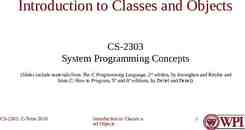Quadratic Functions, Quadratic Expressions, Quadratic
27 Slides156.00 KB
Quadratic Functions, Quadratic Expressions, Quadratic Equations Definition: A quadratic function is a function of the form 2 f ( x) ax bx c where a, b, c are real numbers and a 0. The expression on the right-hand-side 2 ax bx c is call a quadratic expression.
Quadratic Expressions: Factored Form Examples: 2 1. x 5 x 6 quadratic exp. 2. 2 x 2 5 x 3 quadratic exp. ( x 2)( x 3) factored form (2 x 1)( x 3) factored form
Factoring quadratic expressions: Given ax integers. 2 bx c Case 1: a 1; Since where a, b, c are 2 x bx c ( x p)( x q) x( x q) p( x q) 2 x qx px pq 2 x ( p q) x pq
we have 2 x bx c ( x p )( x q ) if and only if b p q and c pq
Examples: 2 x 6x 8 2 x 2 x 15 2 x 7 x 12 2 x 6x 5
2 Case 2: ax bx c integers and a 1. where a, b, c are Since 2 (rx p)( sx q) rsx rqx psx pq 2 rsx (rq ps) x pq
we have 2 ax bx c (rx p )( sx q ) if and only if rs a, rq ps b, pq c
Examples: 2 2 x 5x 3 2 3 x 16 x 5 2 6x 7x 3
Quadratic Equations: A quadratic equation is an equation of the form: 2 ax bx c 0 Problem: Find the real numbers x, if any, that satisfy the equation. The numbers that satisfy the equation are called solutions or roots.
Methods of Solution: 2 ax bx c 0 Method 1: Factor 2 ax bx c 2 If ax bx c (rx p )( sx q ) then the solutions (roots) of the equation are p x1 r and q x2 s
Examples: 2 x 2 x 15 0 ( x 5)( x 3) 0 x 5, x 3 2 2 x 7 x 3 0 (2 x 1)( x 3) 0 1 x 3, x 2
Method 2: Use the QUADRATIC FORMULA The real number solutions (roots) of the quadratic equation 2 ax bx c 0 are: 2 2 b b 4ac b b 4ac x1 , x2 2a 2a provided 2 b 4ac 0.
The quadratic formula is often written as 2 b b 4ac x 2a 2 The number b 4ac is called the discriminant.
The Discriminant: Given the quadratic equation 2 ax bx c 0. If: 2 the equation has real, unequal roots 2 the equation has real, equal roots 2 the equation has complex roots b 4ac 0, b 4ac 0, b 4ac 0,
2 (1) b 4ac 0 ; the roots are: 2 2 b b 4ac b b 4ac x1 ; x2 2a 2a 2 (2) b 4ac 0; the roots are: b x1 x2 2a 2 (3) b 4ac 0; no real roots.
Examples: 2 2 x 7 x 3 0 2 ( 7) ( 7) 4(2)(3) x 2(2) 7 49 24 7 25 7 5 4 4 4 7 5 7 5 1 x1 3, x2 4 4 2
2 x 3x 5 0 3 32 4(1)( 5) x 2(1) 3 29 2 3 29 x1 , 2 3 29 x2 2
3x 2 4 x 4 0 b 2 4ac ( 4) 2 4(3)(4) 16 48 32 0 No real roots.
Quadratic Functions: 2 The graph of f ( x) ax bx c is a parabola. The graph looks like if a 0 if a 0
Key features of the graph: 1. The maximum or minimum point on the graph is called the vertex. The xcoordinate of the vertex is: b x 2a f ( b / 2a) is the y -coordinate of the vertex.
2. The y-intercept; the y-coordinate of the point where the graph intersects the yaxis. The y-intercept is: f (0) c. 3. The x-intercepts; the x-coordinates of the points, if any, where the graph intersects the x-axis. To find the xintercepts, solve the quadratic equation 2 ax bx c 0.
Examples: Sketch the graph of 2 f ( x) x 2 x 8. vertex: b 2 x 1, f (1) 9; vertex (1, 9) 2a 2 y-intercept: f (0) 8 2 x-intercepts: x 2 x 8 ( x 4)( x 2) 0 x 4, x 2.
2 f ( x ) x 4x 4 Sketch the graph of 4 Vertex: x 2, f (2) 0; (2,0) 2( 1) y-intercept: f (0) 4 2 x-intercept(s): x 4 x 4 0 2 x 4 x 4 0; ( x 2) 0; x 2
Sketch the graph of Vertex: f ( x) x 2 4 x 5 4 x 2, 2(1) y-intercept: f (2) 1; (2,1) f (0) 5 x-intercept(s): x 2 4 x 5 0 has no real solutions.
































